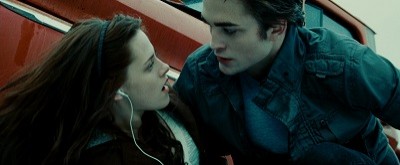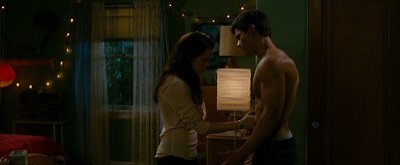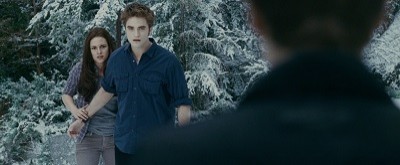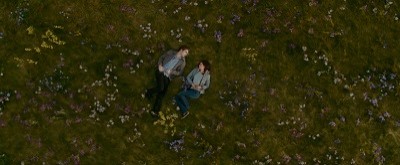| Reviews & Columns |
|
Reviews DVD TV on DVD Blu-ray 4K UHD International DVDs In Theaters Reviews by Studio Video Games Features Collector Series DVDs Easter Egg Database Interviews DVD Talk Radio Feature Articles Columns Anime Talk DVD Savant Horror DVDs The M.O.D. Squad Art House HD Talk Silent DVD
|
DVD Talk Forum |
|
|
| Resources |
|
DVD Price Search Customer Service #'s RCE Info Links |
|
Columns
|
|
|
Twilight Saga; Twilight / New Moon / Eclipse Extended Editions - Triple Feature, The
 When Twilight: Breaking Dawn Part 1 was released on video, it arrived with a new extended cut adding seven more minutes of footage. The implication was that more extended cuts would follow, but the Twilight Forever: Complete Saga Blu-ray set only contained the theatrical versions of the other four films. Now, just over a year later, Lionsgate and Summit have issued The Twilight Saga: Twilight / New Moon / Eclipse Extended Editions - Triple Feature, leaving only one as-of-yet unreleased (and potentially non-existent) extended cut.
When Twilight: Breaking Dawn Part 1 was released on video, it arrived with a new extended cut adding seven more minutes of footage. The implication was that more extended cuts would follow, but the Twilight Forever: Complete Saga Blu-ray set only contained the theatrical versions of the other four films. Now, just over a year later, Lionsgate and Summit have issued The Twilight Saga: Twilight / New Moon / Eclipse Extended Editions - Triple Feature, leaving only one as-of-yet unreleased (and potentially non-existent) extended cut.
Unfortunately, I wasn't aware of any of this when I selected the triple feature from the DVDTalk Screener Pool. As I'd never seen the films before today, I can't expound on what's been added to these versions, but fans waiting to see these new versions (which contain less than 20 minutes of additions between the three films) are now available for them to own in a fairly affordable package.
The Twilight saga, for all its success, remains a contentious pop culture phenomenon, for both worthless and valid reasons. The top two bullet points in the former category are that the films are silly, and, well, essentially that the films are primarily marketed at teenage girls, an audience that the overserved 18-30 young male demographic tends to be unfairly disdainful of. Sure, the Twilight films are eminently ridiculous, but not much more than any work of fiction filled with monsters and magic. Those that would buy into something like Peter Jackson's Lord of the Rings films (equally steeped in fantasy and just as saturated in sentimentality) while booing Twilight on principle is a hypocrite. Different strokes for different folks make the world go round, and young women (and / or old women) have just as much a right to the multiplex as young men.
Farther down the line, a bigger question arises about the messages the films are offering to their audience, and that section of the road is a bit rockier. The films (as if anyone doesn't know) tell the story of Bella (Kristen Stewart), a young girl moving to Forks, Washington to live with her father Charlie (Billy Burke) while her mother Renee (Sarah Clarke) travels with her new ball player husband. On her first day, she is introduced to the Cullens, a band of pale weirdos who keep to themselves at school, indulge in special privileges granted by their parents, and seem as if they've stepped out of another dimension. The one who catches Bella's eye is Edward (Robert Pattinson), a dark-haired, brooding loner even within his band of outsiders, who seems pushed into some sort of fury just by Bella's presence in the same biology class as he is. Of course (spoilers), that's because Edward is a 100+-year-old vampire, fighting back the urge to indulge himself in the only person whose mind he is unable to read.
The need for Edward to constantly hold himself back from Bella, as well as Bella's instant and undying love for Edward, are the source of much hand-wringing about what Twilight teaches teenagers about romance. The author of the book series, Stephenie Meyer, is a Mormon, and there's an obvious parallel in the way that Edward insists on living a certain type of "clean" lifestyle and the way Mormons are meant to abstain from sin. It's a reasonable metaphor, but also presented (at least in the first three films) in a way that fails to acknowledge or distinguish itself from any other interpretations of a man having almost no control over his primal desire for a woman. Paired with Bella's obsessiveness, which takes a positive message of self-empowerment and decisiveness ("I know what I want" is a repeated sentiment), and again, fails to fully distinguish itself from blind emotional insanity, the result is a mixed message worthy of discussion.  At the same time, there's a sense that worrying too much about the audience's ability to separate fantasy from reality fails to grant them a certain measure of intelligence. Twilight has come and gone without any sign that teenagers have ramped up throwing themselves off cliffs or making lifetime decisions at 18 any more than they were before the books or movies arrived on the scene. Any parents concerned about the messages should probably just watch the movies with them.
At the same time, there's a sense that worrying too much about the audience's ability to separate fantasy from reality fails to grant them a certain measure of intelligence. Twilight has come and gone without any sign that teenagers have ramped up throwing themselves off cliffs or making lifetime decisions at 18 any more than they were before the books or movies arrived on the scene. Any parents concerned about the messages should probably just watch the movies with them.
That said, the original Twilight is not a very good movie. On paper, Catherine Hardwicke seems like an edgy and interesting choice for the director's chair, but her film is an awkward, sloppy mess from top to bottom. The way the characters speak is awkward on all fronts: word choices are bizarre and unusual, with the bulk of the film's hip banter alternatively coming off overwritten or out-of-touch. Characters speak at one another, bizarre line after bizarre line, and nearly every scene is an exposition dump. In this extended cut, which presumably flows a little more freely than the theatrical cut, many transitions are still jarring and strange. The film's visual appearance is drab, with Hardwicke bathing the image in deep oppressive blues for most of the film, jarringly reverting back to a perfectly natural color scheme on a couple of random, sunny afternoons. Even the shot blocking stumbles, with cramped close-ups and distracting visual symbolism. A repeated shot where a stuffed owl on a nearby shelf hovers in the background behind Edward. At least once it appears to give him wings in an intentional way, yet other shots are set up so the bird is off-center, becoming a distraction. Hardwicke even contrives a hilarious bit of business to get the novel's famous cover in the film. On top of all that, there's the ludicrous baseball game, which ranks among the most head-scratching and unintentionally hilarious blockbuster sequences of the 21st century.
It doesn't help that Stewart and Pattinson are at their worst in the first film, struggling to find their footing in a script that doesn't give them much to work off of. Here, they have no chemistry together, with Pattinson frequently looking uncomfortable and Stewart's line readings frequently coming off flat and dull as she pledges her undying devotion to him. A sequence where they fly through the trees, her on his back, should be exhilarating, but Hardwicke's execution and their awkward interaction saps the moment of life. The only actor in the first film to register as not only a real person but also an authentic teenager is Anna Kendrick, as Bella's friend Jessica. She's got a certain dorkiness in the first film that seems like Kendrick drawing on her own relative inexperience. Facinelli, as patriarch Carlisle Cullen, also manages a certain otherworldly charisma.
Amazingly, everything changes for the better in New Moon. Under the direction of About a Boy's Paul Weitz and with the support of a much-improved screenplay by Melissa Rosenberg (who adapted all five Twilight films), Pattinson and Stewart's chemistry suddenly blossoms, their performances improve immensely (anyone who suggests Stewart doesn't show any personality or emotion in the series is just kidding themselves), the visuals take on a much more appealing natural appearance, and the picture flows nicely. Weitz and Rosenberg don't try and talk down to the audience, and find a nice tonal balance between melodrama and high drama. When Bella crashes a motorcycle into a rock and the handsome Jacob (Taylor Lautner) runs over and pops his shirt off to dab the blood on her head, the moment manages to wink and indulge the audience at the same time.
In this chapter, Edward leaves Bella, believing their relationship to be a danger to her. Heartbroken, Bella turns to Jacob, fully introducing the love triangle that captured imaginations everywhere. Bella is torn between Jacob's calming presence and the desire to try more and more extreme things to get Edward's attention, who still seems to share some sort of psychic link with her. Bella's fatalistic obsession with true love despite still being in high school is troubling, and Weitz can't totally avoid some of her hyperbolic desperation to be with Edward, nor the reason with which Edward speaks. Still, he pulls some of the same desperation out of Pattinson eventually, evening the keel as much as possible. Directorially, he throws a little flair in with a couple of handsome montage sequences, and the action is better even when the effects are somewhat dodgy (at the very least, they're all a big improvement over thunderstorm baseball).
Still, he pulls some of the same desperation out of Pattinson eventually, evening the keel as much as possible. Directorially, he throws a little flair in with a couple of handsome montage sequences, and the action is better even when the effects are somewhat dodgy (at the very least, they're all a big improvement over thunderstorm baseball).
Eclipse falls somewhere in between the first two, with Weitz handing directing duties over to David Slade (30 Days of Night). The story finds the Cullens concerned about a band of fresh vampires rounding up an army in Seattle, as well as the ongoing threat posed by Victoria (Rachel Lefevre in Twilight and New Moon, Bryce Dallas Howard from Eclipse on), still looking to exact revenge on Edward for killing her boyfriend James (Cam Gigandet) at the end of the first film. It seems clear that Slade was hired to wrangle the army and other action sequences, and he does a decent job, even if the battle appears to be confined mostly to a single field, and some of his work hems toward choppier modern action trends. He also provides some of the series' more evocative visuals, opting for a darker look, although he does also return to the overly manipulated look of the first film in terms of the color timing. Flashback sequences fleshing out other members of the Cullen clan are also stylish and well-done.
On the other hand, Slade doesn't have the playfulness that Weitz had with the material. His film is colder and more serious than the second, managing to come up less saturated with Bella and Edward's affections despite the fact that Edward was MIA for most of New Moon. Most of their thread involves Bella continually pushing Edward to turn her, which is frustrating for reasons that stretch all the way back to the first film. When Bella goes to visit her mother in Jacksonville, or thinks about her father, and especially when Edward stresses the challenges of being the undead, there's something missing. The film waits until the end before giving Bella the opportunity to restate her desire in a different way. Although it's probably something taken out of the book, the films would've benefitted from having that speech arrive upfront, as it does a decent job of rooting her desire in some sort of decision-making process rather than assuming the audience is entirely on her side by default). Before the film gets there, the viewer is subject to an entire film's worth of rivalry between Edward and Jacob, in which Jacob comes off as a pushy asshole forcing himself on Bella. A scene where she rebuffs his advances by full-on punching him in the face is nice, but he continues to guilt-trip her in a way that feels gross right up until the end.
In the years since Breaking Dawn, The Hunger Games has succeeded Twilight as the dominant YA franchise. That franchise has endured less criticism, likely stemming from the sense that those films express a stronger social message, one that hints at larger political ideas and sci-fi concepts. It's a silly line to draw. Twilight never presents itself as more than an over-saturated fantasy romance, and in the hands of talented filmmakers, it works on the intended, melodramatic level. The notion that the questionable subtextual details are too damaging to be discussed or the films are more ridiculous than any other blockbuster are overblown. Every audience thirsts for escapism, and viewers could do both better and worse than Twilight.
The Blu-ray
The Twilight Saga Extended Cut Triple Feature arrives in a single-width eco-friendly Viva Elite Blu-ray case with a flap tray housing the extra disc (it's the version of these cases I like less, with trays on the front and back covers instead of two trays on the tray). The front cover is little more than the faces of the films' three stars inside an intricate purple border, and the back cover is dominated by text. There is no slipcover, and a UltraViolet Digital Copy code for all three films in their extended format is included on a leaflet inside the case.
The Video and Audio
With nothing else on the discs to take up space, the 2.39:1 1080p AVC transfers and DTS-HD Master Audio 5.1 soundtracks for all three extended cuts are pretty impeccable. The first film features the heaviest re-grading, with the darkened skies of the Pacific Northwest cast a blue light over the characters, turning skin pale and muting the surrounding colors. (As a Seattle-area native, I dispute the film's accuracy.) When the action travels out of Forks and into the desert, the picture is really very impressive, allowed the full range of colors, a trend which goes away for the second film but returns to a lesser degree for the third.  Black levels are very heavy, even impenetrable in a few moments, but there's nothing about the look of the movies that makes me think this is anything less than intentional. Fine detail is good when it peers out of the darkness, and there are no compression artifacts or instances of banding to speak of. The three films become increasingly action packed, starting with the baseball game in the first film and increasing to a couple of full-on fight sequences in the third film, each one packed with a number of engaging and immersive soundscapes that envelop, jumping from high end of the spectrum straight down into rumbling bass. Each film is also armed with a lossy Dolby Digital 5.1 Spanish soundtrack, English captions for the deaf and hard of hearing, and Spanish subtitles.
Black levels are very heavy, even impenetrable in a few moments, but there's nothing about the look of the movies that makes me think this is anything less than intentional. Fine detail is good when it peers out of the darkness, and there are no compression artifacts or instances of banding to speak of. The three films become increasingly action packed, starting with the baseball game in the first film and increasing to a couple of full-on fight sequences in the third film, each one packed with a number of engaging and immersive soundscapes that envelop, jumping from high end of the spectrum straight down into rumbling bass. Each film is also armed with a lossy Dolby Digital 5.1 Spanish soundtrack, English captions for the deaf and hard of hearing, and Spanish subtitles.
The Extras
No extras are included, a fact that is even mentioned on the packaging in the fine print. The discs do, however, also include the theatrical editions of the films in question, via branching.
Conclusion
For the fans that have been patiently waiting for the Extended Editions of the first three Twilight films films, here they are, in a low-budget, no-frills package. As a newcomer, the movies are better than expected, but the only one in this batch worth going to bat for is the second one, carefully guided along a tightrope of sincerity and silliness. Ultimately, I side with the fans in stamping this set recommended, mostly because I imagine I'll be in a thin crowd seeing the films for the first time in this way.
Please check out my other DVDTalk DVD, Blu-ray and theatrical reviews and/or follow me on Twitter.
|
| Popular Reviews |
| Sponsored Links |
|
|
| Sponsored Links |
|
|
| Release List | Reviews | Shop | Newsletter | Forum | DVD Giveaways | Blu-Ray | Advertise |
|
Copyright 2024 DVDTalk.com All Rights Reserved. Legal Info, Privacy Policy, Terms of Use,
Manage Preferences,
Your Privacy Choices | |||||||














